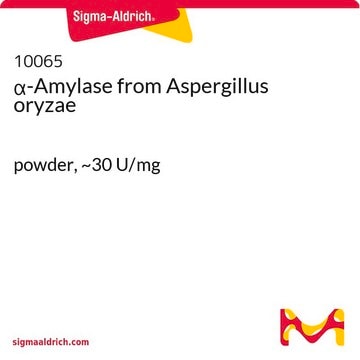A6380
α-Amylase from Bacillus sp.
Type II-A, lyophilized powder, ≥1,500 units/mg protein (biuret)
Synonym(s):
Alpha-Amylase, Glycogenase, 1,4-α-D-Glucan-glucanohydrolase
About This Item
Recommended Products
biological source
bacterial (Bacillus amyloliquefaciens)
type
Type II-A
Assay
≥30%
form
lyophilized powder
specific activity
≥1,500 units/mg protein (biuret)
mol wt
50-55 kDa by SDS-PAGE
technique(s)
SDS-PAGE: suitable
solubility
H2O: soluble 0.1 mg/mL, clear, colorless
suitability
suitable for hydrolysis, synthesis of oligosaccharides and polysaccharides, and sugar modification
application(s)
life science and biopharma
storage temp.
−20°C
Looking for similar products? Visit Product Comparison Guide
General description
Application
- as a component of salivary fluid to perform artificial mastication; in luminal gastrointestinal digestion experiment
- as a standard in sodium dodecyl sulfate-polyacrylamide gel electrophoresis (SDS-PAGE) to determine the concentration of α-Amylase
- to de-starch the alcohol insoluble residue (AIR) for non-cellulosic neutral monosaccharide analysis
Biochem/physiol Actions
Features and Benefits
- α-Amylase from Bacillus licheniformis NCIB 6346 retains over 98% of its activity after 60 minutes at pH 6.2 and 85°C.
- Other α-Amylase maintain 100% of their activity after storage for 1 hour at 91°C.
Unit Definition
Preparation Note
Other Notes
substrate
Signal Word
Danger
Hazard Statements
Precautionary Statements
Hazard Classifications
Resp. Sens. 1
Storage Class Code
11 - Combustible Solids
WGK
WGK 1
Flash Point(F)
Not applicable
Flash Point(C)
Not applicable
Personal Protective Equipment
Certificates of Analysis (COA)
Search for Certificates of Analysis (COA) by entering the products Lot/Batch Number. Lot and Batch Numbers can be found on a product’s label following the words ‘Lot’ or ‘Batch’.
Already Own This Product?
Find documentation for the products that you have recently purchased in the Document Library.
Customers Also Viewed
Protocols
Follow our procedure for the determination of alpha-Amylase activity. This enzymatic assay of a-Amylase guides you through the entire process and necessary calculations.
Follow our procedure for the determination of alpha-Amylase activity. This enzymatic assay of a-Amylase guides you through the entire process and necessary calculations.
Follow our procedure for the determination of alpha-Amylase activity. This enzymatic assay of a-Amylase guides you through the entire process and necessary calculations.
Follow our procedure for the determination of alpha-Amylase activity. This enzymatic assay of a-Amylase guides you through the entire process and necessary calculations.
Our team of scientists has experience in all areas of research including Life Science, Material Science, Chemical Synthesis, Chromatography, Analytical and many others.
Contact Technical Service










